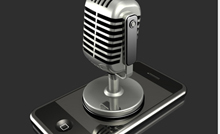
The iPhone hasn’t failed me yet.
It’s now three years since I began #iphonereporting — doing all my field audio and video recording, editing, and transmission, as well as photos, web writing, and social networking solely on my iPhone and iPad.
So far, so good. Not perfect, but what in life or business is?
Covering Washington, D.C., for all-news WTOP-FM and wtop.com solely with an iPhone presents opportunities and challenges, and still the occasional “is that all your equipment?”
In the time since I last detailed my #iphonereporting experience for PBS MediaShift, my use of the technology has changed more than the technology itself.
The Microphone Challenge
I’m surprised (and a bit disappointed) that companies developing microphones for iOS devices haven’t come up with a product that would both improve my sound, without adding bulky accessories.
I’ve estimated the sound quality of the built-in microphone of the iPhone as 92 percent as good as a typical field microphone with a digital recorder.
I’ve tested several compact microphones built for iPhones, as well an XLR adapter cable which allows me to plug a standard microphone into the iPhone.
The more expensive compact microphones — costing between $75 and $110 — generally do provide a richer, more bassy tone, than the slightly metallic-sounding built-in microphone in the iPhone.
However, in each case, the microphones also introduce an unacceptable amount of “digital noise” into the recording.
While the “noise” is inaudible, it is visible when looking at the WAV or MP3 file.
By the time the audio runs through the radio station’s compression and limiting equipment, the end user hears distorted audio.
My conclusion so far: I have not found a microphone solution that improves sound enough to outweigh the inconvenience of carrying a microphone and cables.
Here’s a video I made explaining how to turn your iPhone into a mic using the built-in mic:
Using Mic Accessories
So, right now there are only two instances where I use microphone accessories — when shooting video, and when using a mult box at news conferences.
The positioning of the built-in microphone on the bottom of the iPhone makes it nearly impossible to record good audio while shooting video with the iPhone turned horizontally for landscape orientation.
A handheld microphone with an XLR adapter allows the multimedia journalist to hold the mic in front of the interviewee’s mouth for superior audio.
The other time I use the XLR adapter is when covering a news conference, if I’m not able to mount my iPhone on the podium. The XLR connection plugs into the mult box, while the 1/8 inch jack plugs into the headphone/microphone jack of the iPhone.
One must-have accessory is a foam windscreen, because the iPhone’s built-in mic is so susceptible to wind. It costs under five bucks at a music store, and while it looks a bit dopey to jam the beautiful iPhone into a low-tech piece of foam, it works.
Apps and Other Things in My ‘Go-To’ Kit
I continue to use multi-track editing apps made by Vericorder — namely 1stVideo ($9.99) and AudioPro ($6.99) — as my main editing platforms for more complicated wraps. They allow me to easily pull cuts, record and edit my voice tracks, layer with natural sound or music, and email about two minutes of audio to the newsroom.

I’ve been using the free SoundCloud app for quickly uploading and sharing longer segments of audio. Often, after recording a news conference on my iPhone I’ll quickly upload the entire news conference to SoundCloud, which is equivalent to YouTube for audio.
When you upload audio to SoundCloud, you get a URL which can be quickly shared with Twitter, Facebook and email. Our web desk can get quotes, and our on-air desk can pull sound bites, while I’m choosing the audio I’ll use in my wraps.
One big technical improvement for iPhone reporting is the availability of mobile hot spots. Being able to connect to WiFi in the field allows for much quicker transmission of audio files, and also improves the stability of a report filed via Skype.
For live reporting, I still have not found a better-sounding, less-expensive mobile voice-over-IP (VoIP) solution than free Skype, paired with a mobile hot spot.
My go-kit these days includes:
- iPhone (used for most audio, video, and photo applications)
- iPad (generally used for writing longer web stories and live tweeting)
- windscreen for iPhone
- several charging cables for car and indoor charging
- a power inverter which plugs into a car lighter, to charge iOS devices.
I’m using the iPhone 4S and first-generation iPad, but plan to upgrade to the iPhone 5 and iPad Mini.
No turning back
So, three years into iPhone reporting I don’t think I’ll be turning back to “the way it’s always been done.”
I’ve handed in the laptop that sat unused in the back of my work car for two years. It still stinks to type on iPads and iPhones, but it’s doable.
Even as iPhone reporting technologies continue to improve, I try to stress they’re just tools.
It’s still up to the multimedia reporter to learn and use journalistic standards, fairness, perspective, and taste, because they don’t have an app for that.
UPDATE (11/15/12): Augenstein has donated his iPhone 4S and a customized stand to the Newseum, reports Poynter’s Jeff Sonderman.
iPhone with microphone photo illustration by Norebbo.
For the past 16 years, Neal Augenstein has been an award-winning reporter with WTOP-FM and wtop.com in Washington, D.C. He’s the first major-market radio reporter to do all his field reporting on an iPhone. Neal is a frequent contributor to CBS News Radio. Born in Connecticut, he graduated from American University in Washington, with a degree in broadcast journalism. On Twitter, follow @AugensteinWTOP. He blogs at iphonereporting.tumblr.com.
